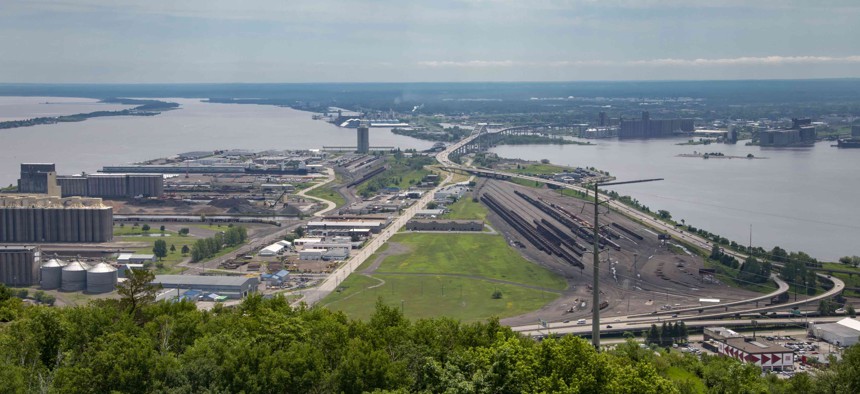Two States to Seek Nearly $900M in Federal Funds for Bridge Project

The industrial harbor and the John A. Blatnik Bridge leading from Duluth, Minnesota to Superior, Wisconsin. Michael Siluk/UCG/Universal Images Group via Getty Images
They’re looking to tap money from the bipartisan infrastructure law approved last year. “This project is a perfect candidate for this funding,” says the governor of one of the states.
To rebuild an aging bridge between Minnesota and Wisconsin, the transportation departments in the two states will seek about $889 million dollars in federal funding available under the infrastructure law approved last year.
The John A. Blatnik Bridge connects Duluth, Minnesota and Superior, Wisconsin, carrying Interstate 535 over waters just off Lake Superior. Completed in 1961, the bridge is 1.5 miles long, including approach spans, and rises 120 feet over St. Louis Bay. It sees an average of about 33,000 cars per day travel over it and serves as a key connection for freight and commercial traffic in the region, an important hub for shipping on the Great Lakes.
Govs. Tony Evers, of Wisconsin, and Tim Walz, of Minnesota, both Democrats, announced that their states would pursue the federal funding for the project.
“The Bipartisan Infrastructure Law provides a once in a generation opportunity to modernize the critical infrastructure that makes our economy work, and this project is a perfect candidate for this funding,” Evers said in a statement Thursday. Earlier this month, he sent a letter to Transportation Secretary Pete Buttigieg registering his support for the project.
Minnesota DOT says there’s widespread corrosion on the bridge’s trusses in areas that are difficult to access. That’s along with other problems, like cables supporting the main truss deck that are showing signs of wear. Officials also note that the bridge relies on outdated structural elements, such as piers that don’t meet modern standards to withstand being hit by ships.
Heavy loads are restricted from traveling over the bridge, with the limit at 80,000 pounds, or roughly half of standard capacity. And, according to Minnesota’s DOT, if the bridge is left as is with its main trusses for another 10 to 15 years, it faces more load restrictions, added maintenance and inspections and eventually a full closure.
A spokesman for the Minnesota Department of Transportation said Thursday that the total cost estimate for the project is around $1.8 billion and that the two states—which own the bridge jointly—would equally split the share of not covered with federal funding.
At this point, the expectation is the bridge would be replaced, rather than rehabbed, the DOT spokesman also said. The states are aiming to begin construction in 2028.
President Biden visited the bridge during a trip to Wisconsin in March, highlighting the infrastructure law. Referring to it, he said: “Your governor is going to use some of the funding from this law to modernize one of the most important bridges in this region.”
The Richard I. Bong Memorial Bridge provides a second connection for travelers between Duluth and Superior. But Minnesota’s DOT says relying on the Bong Bridge alone isn’t a good option.
Officials note that, if the Blatnik were not in service, the Bong Bridge would likely see a wave of extra traffic, that there’d be no redundancy between the bridges in case of emergency, and cars would have to travel about 26 miles round trip to the next nearest crossing, while some freight traffic would have to detour about 75 miles in Minnesota and 50 miles in Wisconsin.
NEXT STORY: AI-powered cameras to enforce bus lanes






